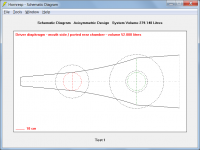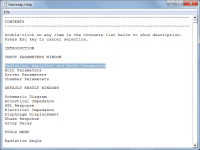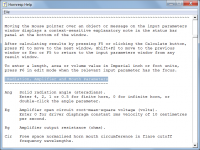Is there any provision for exiting the vent into the horn??
Hi Mark,
Not at the moment. Just thinking about it now though, if Vrc, Lrc, Ap and Lpt were allowed to be used with a tapped horn, then a vented chamber could be specified on the mouth side of the driver diaphragm, with the port exit becoming the mouth tap point. This would be much the same as the existing tapped horn throat chamber and port functionality, just that it would be on the other side of the diaphragm...
Kind regards,
David
Just thinking about it now though, if Vrc, Lrc, Ap and Lpt were allowed to be used with a tapped horn, then a vented chamber could be specified on the mouth side of the driver diaphragm, with the port exit becoming the mouth tap point. This would be much the same as the existing tapped horn throat chamber and port functionality, just that it would be on the other side of the diaphragm...
You is definitely thinking what I wuz thinking.
Most of the mechanics are already there. And being able to move around the vents a little bit would be very, very useful.
First you jumped on the horn wizard, then the filters, no stopping you now!
And parametric EQ! oh the decadence!
Hi Mark,
Not at the moment. Just thinking about it now though, if Vrc, Lrc, Ap and Lpt were allowed to be used with a tapped horn, then a vented chamber could be specified on the mouth side of the driver diaphragm, with the port exit becoming the mouth tap point. This would be much the same as the existing tapped horn throat chamber and port functionality, just that it would be on the other side of the diaphragm...
Kind regards,
David
Hi David,
First of all, nice addition, equalizers....

About the bass reflex in the Unity Horn, I was thinking of it and did not understand the current implementation, so, that was why I started asking about it, some posts back in time.
I had thought my way to a kind of synergy designing with Hornresp to deal with a Unity WITHOUT bass reflex ports combined with my old BassBox Pro to deal with the calculation of the reflex ports and the volume of the bass reflex cabinet. I would not be able to see the end result in Hornresp, but that's OK. I would know how the Horn would act and know how the ports would act. The end result could be projected in my head. Stiil room for a miracle or failure, just as in daily life...
I would ASSUME the following;
1 - The rear chamber of the mid drivers (I wanted to combine low and mid drivers in one driver for say 200 to 1200 Hz, but these would normally be the low drivers in a 3-way Synergy) in the Unity equals the bass reflex cabinet volume.
This would be "Vrc"
2 - The place of the bass reflex ports would be close to the mouth of the Unity Horn, since the location of these ports in the Bass Reflex design don't make a big difference, so why would it be in the Unity Horn.
3 - As a second reasoning for "location don't care", the wave length (¼ of the bass reflex resonance freq. wavelength) is to long anyway to fit in the Horn anyway, so there is nothing to calculate. That's another way of saying, I wanted a small(ish) Horn and I'm not a scientist in Sound Engineering.
4 - The calculation of the BassBox Pro (I NOW know the number of drivers, I know the optimum volume, I know the port volume, I choose a "small" circumference of the reflex ports, and would know the length of the ports) would give me the data for the box surrounding the Unity Horn and acting as a bass reflex cabinet with the Horn inside. The reflex ports are known, so I could find a place at the mouth where they would fit near the mouth of the Unity horn.
Assuming that my assumptions are valid
a - adding the following parameters to the input window (or in a Synergy wizard?);
Np - Number of reflex ports (if set to zero, than a Unity Horn is calculated and there is NO Synergy wizard enabled)
Fb - Resonance frequency of the ports, to be defined by the user
Lrc - Length of the reflexport, to be defined by the user. If set to zero, Hornresp will only calculate port volume.
b - Calculating Vrc by the driver parameters, would be used as the bass reflex cabinet volume (rear chamber volume)
c - Calculating the port Volume value as a result of Vrc, the driver parameters and Fb.
d - Calculate port air speed at Fb (Red if higher than say 30 m/sec) to prevent the design of an air-gun...
d - Calculating the response of the ports ONLY, so not the combined driver / port response as is normally presented.
d - Calculate the combined freq. response, by adding the port response to the already known Unity responce.
e - Plot the combined responce of the Horn.
Since I assumed the port location of lesser importance (IS IT?) we don't care for now. Looking at the Danley versions, I want put all my money on this assumption.
"Ap" & "Lpt" would be used for the taps of the drivers in the Unity Horn, as is right now. "Vrc" would have another implementation if Np set to > 0.
kind regards, Frans Wessels.
Last edited:
Hi wae,
I'll attach a simulation (exported Hornresp .txt file) for the bass section of a unity/synergy horn. Give that a try, maybe it'll help (?).
Regards,
Hi Oliver,
Thanks..
OK, so that would simulate the reflex port by itself in a unity horn, if I understand this correctly? I will take a closer look what you exactly did this weekend (it's now 23:15 and tomorrow is a busy day at one of my customers..)
My shot in the open, was to try and combine the unity horn (set as OD) with an additional bass reflex in 1 design.
So I would see the complete end result, which is not possible in the current version, as far as i understand Hornresp. Hence my proposal to extend Hornresp.
kind regards,
Frans Wessels
Last edited:
To Post #4348
Hi wae,
This is an attempt to show the bass driver in a unity horn w/ a bass reflex port. The driver(s) enters the conical horn @ S2 (OD), and the sound travels up and down the horn S1-S5, and exits @ S5. There is a throat chamber (Vtc) between the driver(s) and S2, and a back chamber (Vrc) between the driver and the port exit (Ap).
Bye the way, the Comment say BP4, that should be BP6 (I just used an old simulation).
Please, take all this w/ a good size grain of salt. The unity/synergy horns are just not that easy; e.g. the throat entry into the horn does not have to be just the thickness of your building material, it could be longer, or shorter. You'll get to a point very quickly where you'll have to take the design into AkAbak, or make some sawdust, and measure.
Regards,
Hi wae,
This is an attempt to show the bass driver in a unity horn w/ a bass reflex port. The driver(s) enters the conical horn @ S2 (OD), and the sound travels up and down the horn S1-S5, and exits @ S5. There is a throat chamber (Vtc) between the driver(s) and S2, and a back chamber (Vrc) between the driver and the port exit (Ap).
Bye the way, the Comment say BP4, that should be BP6 (I just used an old simulation).
Please, take all this w/ a good size grain of salt. The unity/synergy horns are just not that easy; e.g. the throat entry into the horn does not have to be just the thickness of your building material, it could be longer, or shorter. You'll get to a point very quickly where you'll have to take the design into AkAbak, or make some sawdust, and measure.
Regards,
David,Just thinking about it now though, if Vrc, Lrc, Ap and Lpt were allowed to be used with a tapped horn, then a vented chamber could be specified on the mouth side of the driver diaphragm, with the port exit becoming the mouth tap point. This would be much the same as the existing tapped horn throat chamber and port functionality, just that it would be on the other side of the diaphragm...
Yup, that would "get 'er done" for a large variety of current speaker designs that can't be modeled properly using Hornresp presently.
I'd still check the results empirically, but would be fun to be able to sim a few (dozen) designs floating around in my cranium
Art
could this be implemented in Hornresp by;
Hi Frans,
As Oliver says - it's time to take your design into AkAbak
Unity/Synergy'ish DIY AkAbak Scripts
Download - Akabak
Kind regards,
David
Last edited:
And being able to move around the vents a little bit would be very, very useful.
Yup, that would "get 'er done" for a large variety of current speaker designs that can't be modeled properly using Hornresp presently.
Hi Mark & Art,
As a first step, I will have a look at how much work would be involved in adding the new functionality. Implementing the required changes would not be be a trivial exercise, but I think it should be "doable".
Kind regards,
David
would not be be a trivial exercise
It seems I am developing a stutter.
It seems I am developing a stutter.
It's been happening for some time really!
As advised in earlier posts - it's not going to happen.
But I'm so happy that it morphs into:
I changed my mind, it’s not the first time I've done that.

I get that one a lot.

Yes I enjoy picking on you David.
And you are always very gracious.
But looking at the first version of this program you let loose on us, and compare it to what you have designed now.
Wow! Really serious capabilities have been integrated into a very capable program to begin with. I have not even turned on AkaBak for over a year. Just try to think of a way that I can simulate parts in Hornresp.
I contacted you years ago and said this program is worth spending money on and was very willing to do it.
That is an understatement if there ever was one.
Moving up to invaluable.
Hi Frans,
As Oliver says - it's time to take your design into AkAbak.
Unity/Synergy'ish DIY AkAbak Scripts
Download - Akabak
Kind regards,
David
Hi David,
Well, I guess you all are right. That will take some time, I will first try to work with Hornresp. Suits most of my goals for now. The synergy is a longer term project anyway. Tapped horns start turning out nicely. I've just build the 4th version and it works as designed.
I just found out that, thanks to the comments of Oliver, I used Hornresp the wrong way. While I thought I had a good Unity horn SIM with a very nice response graph, it turned out to be NOT the horn that I expected to have designed.
There is on old saying: "A fool with a good tool is still a fool". Well, .... uuhm. YEP. It's me who did it wrong, so plenty of room for improvement from my part.
Thanks for this very useful tool.
kind regards,
Frans Wessels.
Thanks David
I RTFM carefully this time so now I have played around both with the max SPL tool as well as with the effect of adding a serial capacitor to a frontloaded horn. Adding one works similar to reducing the back chamber volume around the high pass fall shaping the sharpness of the knee.
I RTFM carefully this time so now I have played around both with the max SPL tool as well as with the effect of adding a serial capacitor to a frontloaded horn. Adding one works similar to reducing the back chamber volume around the high pass fall shaping the sharpness of the knee.
Hornresp Update 3450-140421
Hi Everyone,
CHANGE 1
A horn-loaded vented-box enclosure can now be specified with the port exit located inside the horn mouth. Select the tapped horn option and set Vrc, Lrc, Ap and Lpt > 0, with L12 = 0.01 cm if the driver is not offset.
CHANGE 2
When selected from the Loudspeaker Wizard, the Filter Wizard now opens with the most recently used Active or Equaliser filter settings, rather than always defaulting to the Active option.
CHANGE 3
A table of contents has been added to the beginning of the Help file. Double-clicking on any item in the contents list shows the relevant Help file description.
Kind regards,
David
Hi Everyone,
CHANGE 1
A horn-loaded vented-box enclosure can now be specified with the port exit located inside the horn mouth. Select the tapped horn option and set Vrc, Lrc, Ap and Lpt > 0, with L12 = 0.01 cm if the driver is not offset.
CHANGE 2
When selected from the Loudspeaker Wizard, the Filter Wizard now opens with the most recently used Active or Equaliser filter settings, rather than always defaulting to the Active option.
CHANGE 3
A table of contents has been added to the beginning of the Help file. Double-clicking on any item in the contents list shows the relevant Help file description.
Kind regards,
David
Attachments
- Home
- Loudspeakers
- Subwoofers
- Hornresp




